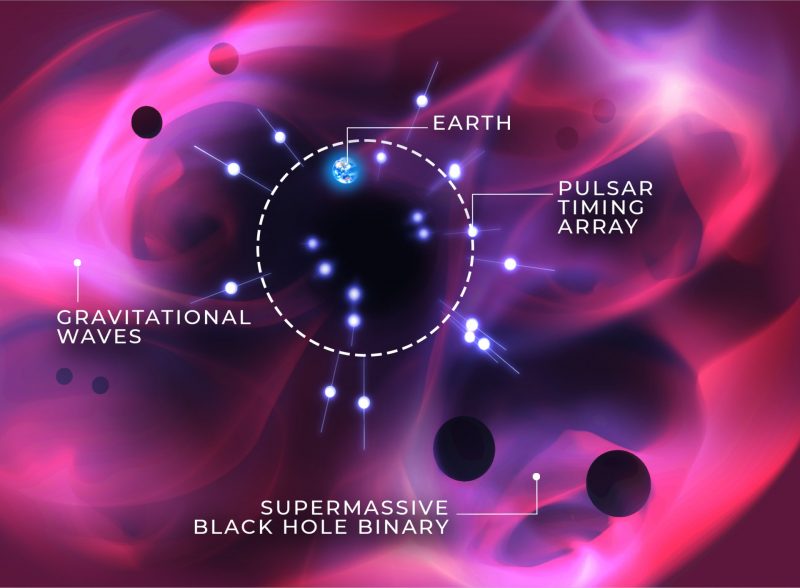
A gravitational wave background?
A “clock” is just a mechanism for keeping time. We use astronomical clocks sometimes, like a single spin of Earth (a “day”) or a single revolution of Earth in orbit around our sun (a “year”). Astronomers associated with the International Pulsar Timing Array (IPTA) use a system of millisecond pulsars as a clock. They use them to probe the passage of gravitational waves. Massive objects – such as two black holes in a binary system – create gravitational waves. These sorts of waves give us another way to study both the black holes (which tend to reside in the centers of galaxies in the early universe) and the gravitational waves themselves. IPTA announced its 2nd data release this month (January 2022). These astronomers said they’ve now discovered what could be the early sign of a gravitational wave background, arising from supermassive black holes.
They said they don’t have definitive prooof of a gravitational wave background signal yet. But, they said, they believe they’re getting closer.

Using pulsars as ‘clocks’
How do these scientists gather their data? How can they study something so elusive as a background signal of gravitational waves? IPTA is a collaboration between several institutions across the globe, including the European Pulsar Timing Array (EPTA), the North American Nanohertz Observatory for Gravitational Waves (NANOGrav), and the Parkes Pulsar Timing Array (PPTA). The group’s statement exploits the fact that the pulses of millisecond pulsars – stellar remnants left behind by supernova explosions, spinning hundreds of times per second – are extremely steady. Their arrival times can be predicted. The group measures disturbances in the steady signals from about 65 pulsars to learn that a gravitational wave has passed.
The IPTA experiment can be compared to Earth-based interferometric detectors such as LIGO and VIRGO, of which you might have heard. Those ground-based systems were the first to detect gravitational waves, beginning around 2015. IPTA’s first data release was in 2016. LIGO and VIRGO use Earth-based lasers to create detectors that are several kilometers long. In contrast, the “arms” in the IPTA detector is the distance in space between millisecond pulsars. So the IPTA detector “arms” are thousands of light-years long.
So IPTA probe a different frequency range in gravitational waves. The source of the gravitational waves detected by IPTA tends to be supermassive black hole systems – binary black holes, or two orbiting around each other – with a total mass billions of times that of our sun. Many such objects are thought to exist in the cores of the great galaxies islands around us in space, a result of galaxy mergers over time.

These astronomers said in their statement:
Research of the combined IPTA 2nd data release, and other independent data sets from the three constituent collaborations, has revealed strong evidence for this new low-frequency gravitational wave background signal, correlated many of the pulsars. The characteristics of this common-among-pulsars signal are in broad agreement with those expected from a gravitational wave background. This background is formed by many different overlapping gravitational wave signals emitted from the cosmic population of supermassive binary black holes … analogous to background noise from the many overlapping voices in a crowded hall.
This result further strengthens the gradual emergence of similar signals that have been found in the individual data sets of the participating collaborations over the past few years.
But scientists caution they do not yet have definitive evidence for the gravitational wave background. And they are still looking into what else this signal could be, while gathering more information to strengthen their findings. The ‘smoking gun’ for a gravitational wave detection is a unique relationship in the strength of the signal between pulsars in different parts of the sky. While these ‘spatial correlations’ have not yet been detected, the existing signal is consistent with what scientists expect to see at first.
The IPTA is working diligently to analyze more recent data, which could confirm the nature of the new signal …
Astronomer Ryan Lynch is a Green Bank Observatory scientist and NANOGrav member. The Green Bank Telescope in West Virginia is participating in IPTA data gathering. Overall, there 65 millisecond pulsars in their system. Twenty of these pulsars were observed by the Green Bank Telescope. Lynch commented:
The IPTA is a great example of scientists and instruments from around the world coming together to advance our understanding of the cosmos … If what we are seeing here is indeed the signature of gravitational waves, then the next few years are going to be really exciting.
The video below, from LIGO, shows an artist’s concept of a merger between two supermassive black holes. This is the interaction that produces gravitational waves.
Bottom line: In its 2nd data release in early January 2022, scientists with the International Pulsar Timing Array announced early glimpses of a gravitational wave background.
The post Are we glimpsing a gravitational wave background? first appeared on EarthSky.
from EarthSky https://ift.tt/3fx2jYB

A gravitational wave background?
A “clock” is just a mechanism for keeping time. We use astronomical clocks sometimes, like a single spin of Earth (a “day”) or a single revolution of Earth in orbit around our sun (a “year”). Astronomers associated with the International Pulsar Timing Array (IPTA) use a system of millisecond pulsars as a clock. They use them to probe the passage of gravitational waves. Massive objects – such as two black holes in a binary system – create gravitational waves. These sorts of waves give us another way to study both the black holes (which tend to reside in the centers of galaxies in the early universe) and the gravitational waves themselves. IPTA announced its 2nd data release this month (January 2022). These astronomers said they’ve now discovered what could be the early sign of a gravitational wave background, arising from supermassive black holes.
They said they don’t have definitive prooof of a gravitational wave background signal yet. But, they said, they believe they’re getting closer.

Using pulsars as ‘clocks’
How do these scientists gather their data? How can they study something so elusive as a background signal of gravitational waves? IPTA is a collaboration between several institutions across the globe, including the European Pulsar Timing Array (EPTA), the North American Nanohertz Observatory for Gravitational Waves (NANOGrav), and the Parkes Pulsar Timing Array (PPTA). The group’s statement exploits the fact that the pulses of millisecond pulsars – stellar remnants left behind by supernova explosions, spinning hundreds of times per second – are extremely steady. Their arrival times can be predicted. The group measures disturbances in the steady signals from about 65 pulsars to learn that a gravitational wave has passed.
The IPTA experiment can be compared to Earth-based interferometric detectors such as LIGO and VIRGO, of which you might have heard. Those ground-based systems were the first to detect gravitational waves, beginning around 2015. IPTA’s first data release was in 2016. LIGO and VIRGO use Earth-based lasers to create detectors that are several kilometers long. In contrast, the “arms” in the IPTA detector is the distance in space between millisecond pulsars. So the IPTA detector “arms” are thousands of light-years long.
So IPTA probe a different frequency range in gravitational waves. The source of the gravitational waves detected by IPTA tends to be supermassive black hole systems – binary black holes, or two orbiting around each other – with a total mass billions of times that of our sun. Many such objects are thought to exist in the cores of the great galaxies islands around us in space, a result of galaxy mergers over time.

These astronomers said in their statement:
Research of the combined IPTA 2nd data release, and other independent data sets from the three constituent collaborations, has revealed strong evidence for this new low-frequency gravitational wave background signal, correlated many of the pulsars. The characteristics of this common-among-pulsars signal are in broad agreement with those expected from a gravitational wave background. This background is formed by many different overlapping gravitational wave signals emitted from the cosmic population of supermassive binary black holes … analogous to background noise from the many overlapping voices in a crowded hall.
This result further strengthens the gradual emergence of similar signals that have been found in the individual data sets of the participating collaborations over the past few years.
But scientists caution they do not yet have definitive evidence for the gravitational wave background. And they are still looking into what else this signal could be, while gathering more information to strengthen their findings. The ‘smoking gun’ for a gravitational wave detection is a unique relationship in the strength of the signal between pulsars in different parts of the sky. While these ‘spatial correlations’ have not yet been detected, the existing signal is consistent with what scientists expect to see at first.
The IPTA is working diligently to analyze more recent data, which could confirm the nature of the new signal …
Astronomer Ryan Lynch is a Green Bank Observatory scientist and NANOGrav member. The Green Bank Telescope in West Virginia is participating in IPTA data gathering. Overall, there 65 millisecond pulsars in their system. Twenty of these pulsars were observed by the Green Bank Telescope. Lynch commented:
The IPTA is a great example of scientists and instruments from around the world coming together to advance our understanding of the cosmos … If what we are seeing here is indeed the signature of gravitational waves, then the next few years are going to be really exciting.
The video below, from LIGO, shows an artist’s concept of a merger between two supermassive black holes. This is the interaction that produces gravitational waves.
Bottom line: In its 2nd data release in early January 2022, scientists with the International Pulsar Timing Array announced early glimpses of a gravitational wave background.
The post Are we glimpsing a gravitational wave background? first appeared on EarthSky.
from EarthSky https://ift.tt/3fx2jYB

Aucun commentaire:
Enregistrer un commentaire